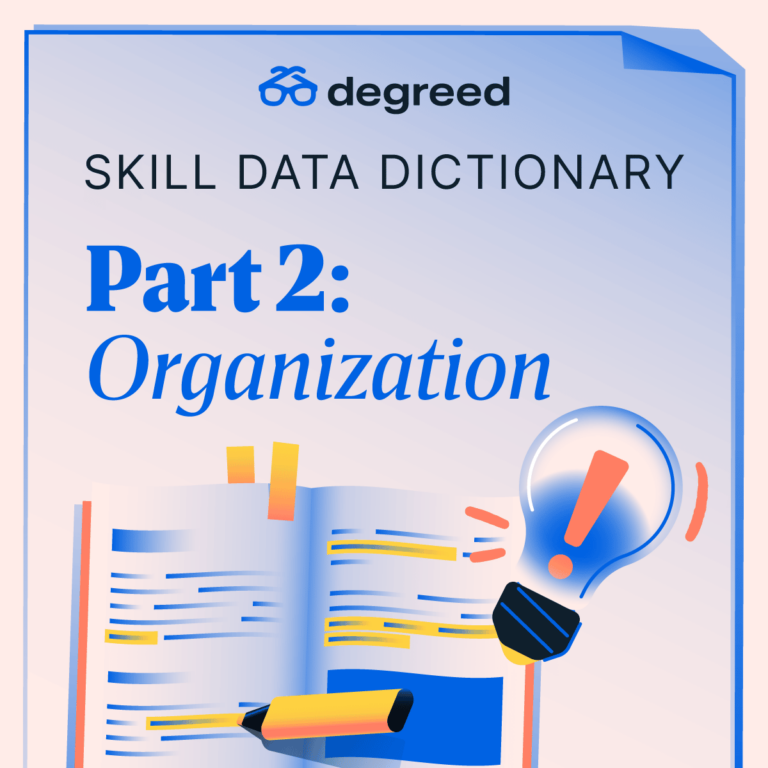
Skill Data Dictionary Part 2: Organization
Welcome back to our Skill Data Dictionary series. If you haven’t already, we recommend you review Part 1, in which we cover the skill data basics.
This blog will expand beyond the basics into the different methods of structuring your organization’s skill data. There are many overlapping (or even contradictory) ideas in the market about what it means to have a skill strategy and how that relates to a skill taxonomy or ontology.
These ideas aren’t inherently simple, but they don’t need to be overly complicated. That’s why we’re breaking them all down for you below.
Organizing Skill Data
Skill Strategy
Definition: A strategy for talent development that prioritizes skills as a way to measure the ability of your people. This measurement is then aligned with the work that your organization needs to get done and the career opportunities that exist internally. Skill strategies can vary greatly between companies and can use any combination of upskilling technology, skill taxonomies, skill ontologies, skill clouds, or none of those.
Why it matters: Using a skill strategy as opposed to a competency model (or in tandem with one) can help make your workforce more agile and enable opportunities for internal mobility and career growth.
Skill Taxonomy
Definition: A hierarchical system of classification that can categorize and organize skills in groups or “skill clusters.” A skill taxonomy is very structured and will usually include the skills that are most important to business goals, sometimes with the skills’ definitions as well.
Why it matters: This can help workers understand which skills they have from the taxonomy, how they relate to organizational needs, and what they should learn next. It can also help show what skills are included in various categories of skills. The purpose of the framework is not to capture every skill, but rather to capture information about the most essential skills that are relevant to your business strategy.
Skill Ontology
Definition: A set of skills and their relationships between one another.
Why it matters: A skill ontology allows organizations to define and measure relationships between skills (and even jobs and people). It helps create a common language and understanding of skills across a variety of different dimensions or platforms. For example, across individuals, teams, and companies, the definition and terminology used to describe a UX designer will vary. A skill ontology is able to aggregate all of that data and recognize that different systems are talking about the same entities and build relationships between them. Another way of looking at an ontology is that it is a “smart system” that helps maintain, aggregate, and simplify the skill data within a taxonomy.
Skill Graph
Definition: A skill graph shows the relationships between other skills and determines how skills map to roles, content, and other skill-related features. It’s often simply a visual representation of a skills ontology.
Why it matters: Understanding how different skills are related to one another (and how closely related) can inform how artificial intelligence and models offer upskilling and mobility opportunities. For more on skill models, check out Part 1 of our dictionary.
Skill Cloud (Also called a Skill Inventory or Skill Registry)
Definition: An inventory of skills across organizations that includes all known skill terms. It is the data set that is used to evaluate skills to include in organizational skill lists, ontologies or taxonomies. It is basically a single source of truth for any skill, but it does not order or categorize skills like a taxonomy does.
Why it matters: A skill cloud helps organize and standardize skills across an organization, but a skill cloud alone does not make these skills actionable. They simply sit in the cloud.
Skills I/O
Definition: Degreed’s Skills I/O (which stands for input/output) is able to manage skills, skill data, and the structures mentioned above. You can use the Skills I/O to build taxonomies, manage multiple skill sources, integrate different taxonomies, and edit the skills in your organization.
Why it matters: Whereas taxonomies, ontologies, and graphs help us understand skills in relation to our business objectives, but our Skills I/O is able to put those concepts into practice together.
For more skill data definitions, keep an eye out for our final installment of the Skill Data Dictionary and download our Ultimate Skill Data Handbook today!

Unser heißer Draht zu Ihnen  .
.
Exklusive Einblicke, Infos zu bevorstehenden Veranstaltungen, Updates zu Degreed-Lösungen – das alles erwartet Sie in unserem monatlichen Newsletter.
Ihre Privatsphäre hat für uns oberste Priorität. Es ist Ihnen jederzeit möglich, Ihre Einstellungen für den Erhalt von E-Mails zu ändern oder Ihr Abonnement abzubestellen. Die von Ihnen bereitgestellten Informationen werden nur verwendet, um Ihnen Mitteilungen entsprechend Ihren Präferenzen zuzusenden. Weitere Einzelheiten hierzu finden Sie in der Degreed-Datenschutzerklärung.